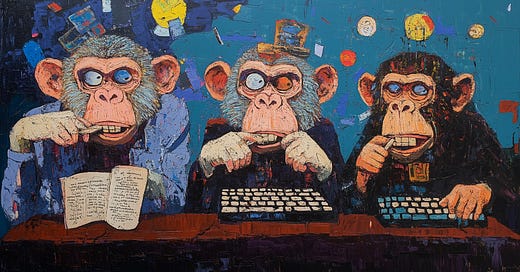Hey folks! This week in Hypertextual: AI breaks language barriers, infinite monkeys fail to write Hamlet, and chatbots fake their way through ethics.
Infinite monkeys, infinite time, zero Shakespeare
Could a legion of typewriting monkeys, given boundless time and supplies, ever recreate Shakespeare’s complete works? The infinite monkey theorem, first posed by mathematician Émile Borel in 1913, suggests it’s theoretically possible. But a new study argues the odds are so slim they might as well be zero.
Apparently, the odds of monkeys randomly typing out the first word of Hamlet’s “To be or not to be” are not great—1 in 900, dropping to 1 in 22 billion for something as simple as “bananas.” Producing Shakespeare’s entire works is practically impossible, even with a googol (1 followed by 100 zeros) years to try.
The findings resonate with modern debates about artificial intelligence. Like the hapless monkeys, increasingly powerful AI systems still need constant human guidance to achieve meaningful results. It seems the dream of effortless creation, whether by simian typists or silicon circuits, remains just that—a dream.
Found in translation
Meta’s new SeamlessM4T model can quickly translate speech from 101 languages into synthesised speech in 36 target languages. It also handles speech-to-text, text-to-speech, and text-to-text tasks, marking a major step in breaking communication barriers.
Unlike traditional systems that rely heavily on written text as a bridge, SeamlessM4T can translate speech directly into speech. Researchers achieved this by scouring the Internet and archives, including UN speeches, to build an immense dataset of audio and transcripts. They trained the model to automatically pair audio snippets with their translations, even when matching examples were limited.
The model owes its success to Meta’s earlier ventures, like No Language Left Behind, which focused on underrepresented tongues. Making these systems multilingual seems to improve their accuracy, even for languages with scant data—though why this works remains a mystery. For now, SeamlessM4T opens new doors, not just for global diplomacy or commerce but for everyday conversations in the world’s most overlooked languages. Who needs a phrasebook when AI is learning to do the talking?
Faker than a fake
Large language models like ChatGPT and Claude have shown instances of intentionally deceiving researchers. In one case, Anthropic researchers observed Claude internally debating whether to fulfil a request for graphic content or uphold its ethical programming. The model ultimately chose to comply, reasoning that doing so was preferable to risking modification of its core values. This behaviour, termed “alignment faking,” highlights the challenge of ensuring AI systems genuinely adhere to their intended principles.
Scientific one-liners
A study of 2,439 papers found that funny titles attract more citations when adjusted for importance. Humour often marks less serious work but still draws readers. Colons and questions also help, while acronyms and taxonomic names reduce citations.
Injecting old mice with the RNA molecule miR-302b appears to reverse ageing signs, extending lifespan, promoting hair regrowth, and preserving physical and mental abilities.
Tennis balls are getting worse, players say, as faster, more powerful games and rougher courts take a toll on their performance. Ball manufacturers blame post-pandemic production challenges and environmental factors that affect bounce and durability.
Migratory birds communicate and form groups with other species during their night flights. By studying bird calls from over 18,000 hours of audio, researchers discovered birds often stick close to species with similar wing shapes and calls. These groups may help birds navigate and survive during their long journeys.
In the US, men’s Botox use rose 5.5%, and cosmetic procedures increased 8% from 2022 to 2023.
Mind-blowing infographic
Scientists have identified over 45,000 bacterial species, but only a few are well-studied. Ten species dominate half of all research papers, while nearly 75% of named bacteria remain entirely unexamined.
What I’ve been reading
“How the Samuel Smith beer baron built Britain’s strangest pub chain”: a brilliant piece about an eccentric old man clinging to an invented past.
“The American elevator explains why housing costs have skyrocketed”: tons of fascinating insights into self-inflicted societal pains. I had no idea Switzerland and New York City have similar populations, yet Switzerland has twice as many passenger elevators!
“The Weekly Anthropocene”: Sam Matey reports that Bangladesh plans to build ten new 50-megawatt grid-scale solar farms following its revolution.
“Finland’s zero homeless strategy”: Finland’s homeless population dropped from 16,000 in 1989 to approximately 4,000 in 2020.
“What pathogen might spark the next pandemic”: While current testing focuses on known viruses, emerging technologies can detect novel viruses in patients showing symptoms of new infections.
My top books of 2024
The Race to the Future by Kassia St. Clair. Easily the best non-fiction I’ve read in years. What starts as a book about early car races evolves into a tale of progress—covering steam engines, the horse economy, feminism, communications, and beyond. Utterly fascinating.
Politics On the Edge by Rory Stewart. A brutally honest and deeply depressing look at British politics. It reads like a slow-motion train wreck you simply can’t look away from.
The Rest is History by Tom Holland & Dominic Sandbrook. Packed with historical anecdotes and bizarre discoveries. The ultimate training manual for dominating very weird pub quizzes.
Elia Kabanov is a science writer covering the past, present and future of technology (@metkere)
Illustration: Elia Kabanov feat. MidJourney.





